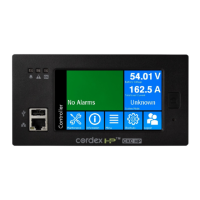0180036-J0 Rev E Page 25
9 Wiring and Connections
9.1 Safety Precautions
This chapter provides cabling details and notes on cable sizing for DC applications with respect to the
product.
WARNING: Hazardous energy levels are present at both the input and the output of power systems.
Ensure that input power and output power is removed before attempting work on the CXC connections.
Use a voltmeter to verify the absence of voltage. Clearly mark the correct polarity of the battery leads
before commencing work on DC connections.
WARNING: The CXC HP and L-ADIO are SELV and Class2 LPS devices so all signals connected to
them must be compliant with the associated energy levels.
NOTE: HV-ADIO connections contain hazardous voltage and should be protected with double insula-
tion. Do not bundle hazardous voltage wires with SELV wires such as CAN, USB, Ethernet or the P-out
for the controller.
WARNING: The intra-building port(s) (Ethernet ports, CAN Bus ports) of the equipment or subassembly
is suitable for connection into intra-building or unexposed wiring or cabling only. The intra-building
port(s) of the equipment or subassembly MUST NOT be metallically connected to interfaces that
connect to the OSP or its wiring. These interfaces are designed for use as intra-building interfaces only
(Type 2 or Type 4 ports as described in GR-1089-CORE,) and require isolation from the exposed OSP
cabling. The addition of Primary Protectors is not sufficient protection in order to connect these inter-
faces metallically to OSP wiring.
WARNING: Interconnect wire shall satisfy the VW-1 requirements contained in ANSI/UL 1581-2001
reference standard for electrical wires, cables, and flexible cords.
Refer to the previous (Installation) chapter for additional safety precautions.
9.2 Front Access
CAUTION: The IO connections on the L-ADIO and other IO devices should be made while wearing an
ESD wrist strap securely connected to a system ground location connected to the terminal block pin
labeled GND (1) of the device being wired.
All wiring connections are accessible from the front of systems when using the 3U rack mount panel
configuration. For example, to gain access to the terminal block connectors for the rack model:
1. Depress the two front panel latches towards the center of the panel.
NOTE: For HV systems, there is a locking feature that requires a flat blade screw driver.
2. Tilt the front panel forward and down.

